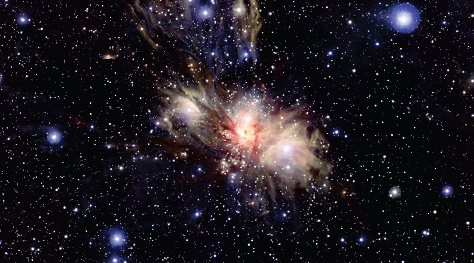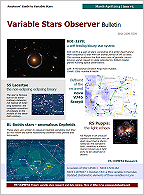Variable Stars Common Observation
Mission in Particular Areas of the Sky
Stellar associations: a variable stars nursery
 by Valery Tsehmeystrenko in
January-February 2014 (#4)
by Valery Tsehmeystrenko in
January-February 2014 (#4) The study of stellar associations and star formation regions is an important activity in the research of stars evolution and their systems. Stellar associations are concentrated along the spiral arms of our galaxy and come in several types. As a place where stars are born, these regions contain different kinds of objects, including variable stars, at the early stages of their life.
The term "stellar associations" was suggested as one of the basic concepts in the galactic astronomy by the outstanding astrophysicist of the Academy of Science of the USSR - V.A. Ambartsumian, in 1948. Stellar associations are sparse groups of loosely bound young stars, which have similar physical properties. The age of such associations does not exceed several tens of millions of years. About 90 percent of all stars originate as members of associations.
 What makes associations different from regular young star clusters is their
larger size and low stellar density. By size, an association can reach 50-100 pc,
but the number of members can be just tens to hundreds of stars overall.
Stellar associations are complex molecular clouds.
What makes associations different from regular young star clusters is their
larger size and low stellar density. By size, an association can reach 50-100 pc,
but the number of members can be just tens to hundreds of stars overall.
Stellar associations are complex molecular clouds.
The weak gravity in associations determines their relatively short (in astronomical terms) lifetime - only 10-20 million years old. Groups' borders are continuously expanding, making it eventually impossible to distinguish an association from the background stars of "old" associations.
Stellar associations are divided into three basic types:
- OB associations, containing mainly massive hot blue-giant stars;
- T associations, containing mainly low-mass T Tauri variable stars;
- R associations (R stands for "reflection"), containing stars of spectral classes O to A2, surrounded by reflection nebulae, gas and dust.
The supergiant is so huge that the blue component is totally eclipsed for 250-300 days, a considerable part of the year. However, precise calculation of its diameter is a serious issue, as it seems to be distorted into a teardrop shape and fills its tidal surface. Due to mass accretion into a disk around the smaller and much hotter companion, the average diameter can be overestimated.
OB associations consist largely of very young, massive stars (about 10 to 50 solar masses) of spectral types O to B2. These stars do not live long, so OB associations are all young. The size of OB associations ranges from 40 to 200 parsecs, and the number of members (spectral type O-B2 stars) is limited to several dozen. T associations are made up of numerous cooler lower-mass dwarf T Tauri stars, which exhibit irregular variations of brightness. R associations are characterized by medium-mass stars. A well-defined lane of R associations extends from Cygnus to Monoceros along the inner edge of the Orion arm. All three types may be found together. The internationally approved designation for associations is the name of the constellation followed by an Arabic numeral (e.g. Perseus OB2).

VISTA infrared image of the starforming region Monoceros R2 within the constellation
of Monoceros (the Unicorn). Image credit: ESO / J. Emerson / VISTA.
Nevertheless, the fact that stellar associations exist within our galaxy, along with other types of star clusters, is an irrefutable proof that the stars are not born alone, but in groups. One of the clearest examples of stellar associations, which can be seen currently in the constellation of Orion, is the "trapezium". This is a group of young blue stars. The Scorpius -Centaurus Association is the nearest OB association to the Sun. It is composed of three subgroups of stars, whose mean distances range from 380 to 470 light years.
The most interesting association type for variable stars researchers are T associations. These are home to relatively cool dwarfs with hydrogen emission lines in their spectra. Nearly 40 of such associations are currently known. These regions are formed by groups of young T Tauri variable stars associated with the clouds of interstellar matter (nebulae) in which they occur. This fact was noted by Ambartsumian and played a significant role in the future development of theoretical ideas about how stars are formed. T Tauri variables are newly formed stars of low mass (three or less solar masses) that are still in the process of contraction. Since T Tauri stars are dwarfs, T associations cannot be observed at great distances. They occur only in or near regions of galactic nebulosity, either bright or dark, and only in obscured regions showing the presence of dust.
T Tauri variable stars are in the stage of evolution before entering the main sequence, with masses less than two solar. They have spectral types of F to M; their rotation periods are on the order of 1 to 12 days. Compared to the main sequence stars, their luminosity is typically greater because of the larger size. There is evidence that their surfaces are covered with spots. Another source of T Tauri brightness variability is a protoplanetary disk surrounding the star.
 The constellation of Cygnus has five T
associations, and Orion and Taurus have four of
them each. The richest is Ori T2, with more than 400
members; it has a diameter of 50 by 90 light-years
and lies at a distance of 1,300 light-years around the
variable star T Ori. This is, perhaps, the best known
example of a stellar nursery, where new stars are
being born, the Orion Nebula (M42) area. Observations
of the nebula have revealed approximately 700
stars in various stages of formation within the nebula.
Also, T associations were discovered in Monoceros,
Perseus, etc.
The constellation of Cygnus has five T
associations, and Orion and Taurus have four of
them each. The richest is Ori T2, with more than 400
members; it has a diameter of 50 by 90 light-years
and lies at a distance of 1,300 light-years around the
variable star T Ori. This is, perhaps, the best known
example of a stellar nursery, where new stars are
being born, the Orion Nebula (M42) area. Observations
of the nebula have revealed approximately 700
stars in various stages of formation within the nebula.
Also, T associations were discovered in Monoceros,
Perseus, etc.
Besides T Tauri variables, another type of variable stars is found in stellar associations - UV Ceti. The most important common feature for those two classes of variable stars is a continuous emission. For UV Ceti stars the emission is observed during outbursts, while for T Tauri stars it appears at various stages of their variability cycle.
The study of variable stars in stellar associations is very important for understanding the fundamental concepts of star formation. Stars at the earliest stages of their evolution are an extremely valuable source of knowledge about the nature of their origin.
10 most recognizable T associations are:
Tau T1 (near RY Tau),
Tau T2 (near T Tau),
Aur T1 (near RW Aur),
Ori T1 (near CO Ori),
Ori T2 (near T Ori, M42),
Mon T1 (near S Mon, NGC2264),
Ori T3 (near Σ, ζ Ori, I434),
Sco T1 (near α Sco, ρ Oph),
Del T1 (near V536 Aql, WW Vul),
Per T2 (I348, ζ Per).
Free Bulletin on Variable Stars
Variable Stars Observer Bulletin is all about variable stars science. It's made by amateurs and for amateurs. Here simplified contemporary data about different aspects of variable stars research is published. The bulletin is scheduled for six issues per year.
Want to contribute an article? Feel free to contact us at:
http://www.vs-compas.belastro.net/bulletin-contribute
or please simply drop an email to [ivan dot adamin at gmail dot com]
 Issue #5
Issue #5
March-April 2014
Free Online
PDF Bulletin on Variable Stars
Amateurs' Guide to Variable Stars
Read Online as e-Magazine
In this issue:
 by Ivan Adamin
by Ivan Adamin
BL Bootis stars - anomalous Cepheids
 by Ivan Adamin
by Ivan Adamin
A revision of NSV 13538 = NSVS 17231162
 by Alexandr Ditkovsky
by Alexandr Ditkovsky
NSVS 11075037 = Dauban V53:
updated elements of a Mira variable in Hercules
 by Siarhey Hadon
by Siarhey Hadon
Pulsating variable stars and the Hertzsprung-Russell diagram
 by Siarhey Hadon, Ivan Adamin
by Siarhey Hadon, Ivan Adamin
RS Puppis: the light echoes calibrate standard candles for accurate distance measurements
 by Ivan Adamin
by Ivan Adamin
SS Lacertae: The non-eclipsing eclipsing binary
 by Ivan Adamin
by Ivan Adamin
>>View Full Contents

|
Statistics Overview
Variables by Type Variables by Magnitude Variables by Period Build Own Criteria |
